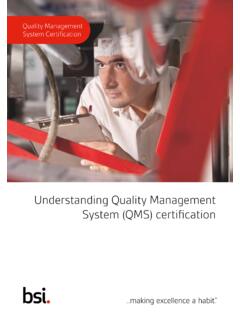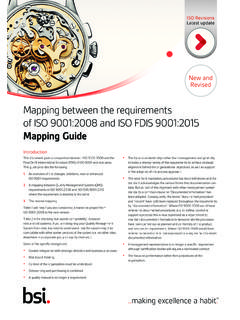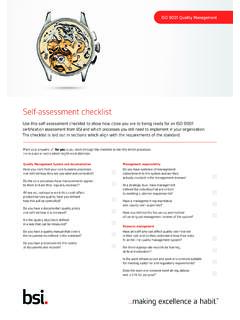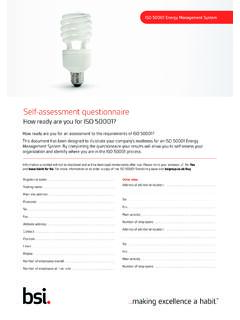Transcription of Clinical evaluation under EU MDR
1 Clinical evaluation under EU MDRA uthor - Dr. Amie Smirthwaite, Global VP for Clinical Services, RMQ+2 Clinical evaluation under EU MDRC ontentsIntroduction and backgroundPurpose of a Clinical evaluationOverview of the Clinical evaluation processClinical evaluation planning Intended purpose, indications , contraindications Intended/expected Clinical benefit Clinical claims Duration of use Establishing the SOTA and benchmarks for safety and performance Purpose of the SOTA evaluationDevices with direct Clinical benefits Devices with indirect, broad or generic Clinical benefitsThe rest of the Clinical evaluation process Data collectionData appraisal and analysisData mapping and conclusions.
2 Including benefit-risk evaluationFrequent notified body findings AcronymsReferences and related . Introduction and backgroundThere has been significant evolution in the European regulatory landscape over the past 10 15 years, particularly with respect to requirements for Clinical evaluation . These changes have been driven in part by a series of medical device failures, which fuelled a perception, particularly amongst regulators and clinicians, that Clinical evidence for medical devices was not receiving sufficient scrutiny in of the early markers of this shift came with the publication of Directive 2007/47/EC in September 2007, which amended the European Active Implantable Medical Devices Directive (90/385/EEC, EU AIMDD) and the European Medical Devices Directive (93/42/EEC, EU MDD).
3 Although the scope of Directive 2007/47/EC was not limited to Clinical evaluation , many of the amendments had a direct impact on Clinical evaluation and postmarket data collection. Amongst these were: A new definition of Clinical data was added to Article 1 of both Directives, including a specification of acceptable sources of Clinical evidence. The requirement for demonstration of conformity with the Essential Requirements (ERs) to include a Clinical evaluation was moved from the design and construction specific section of Annex 1/I to the general section. The implication of this change was that Clinical evaluation was an explicit requirement for all devices, regardless of design or intended purpose.
4 Substantial amendments were made to Annex 7/X ( Clinical evaluation ), including: Clinical investigation required by default for all Class III and implantable devices; any decision not to undertake a Clinical investigation for these devices must be duly justified Clinical evaluation must be documented as part of the technical documentation the Clinical evaluation and its documentation must be actively updated with data obtained from postmarket surveillance if postmarket Clinical follow-up is not deemed necessary, this must be duly justified and the publication of Directive 2007/47/EC, there came a succession of new and revised guidance documents and legislation.
5 The intent of many of these changes was to improve the quality of medical device Clinical evaluations and the scrutiny to which they were subject. Table 1 is intended to be illustrative rather than evaluation under EU MDRYearDocumentImpact on Clinical evaluation assessments2009 MedDev rev 3 Significantly greater content provided regarding the Clinical evaluation process, data appraisal and analysis and validity of conclusions (increase from 19 to 46 pages)2010 NBOG CL 2010-1 Publication of detailed checklist for competent authorities to audit notified body competence to undertake Clinical evaluation assessments2013 Implementing Regulation 920/2013 Begins to increase specificity of Clinical experience required in notified body Clinical evaluation conformity assessments2014 NBOG BPG 2014-22016 MedDev rev 4 Further expansion of the guidance, to reinforce concepts around quality and completeness of Clinical data and scientific validity of conclusions (increase from 46 to 65 pages)2017 Regulation (EU)
6 2017/745 Clinical evaluation requirements largely aligned with MedDev rev 4 become enshrined in EU lawNBOG BPG 2017-2 Further increases specificity of Clinical experience required to undertake a notified body Clinical evaluation assessment2020 MDCG 2020-5 MDCG 2020-6 Guidance reinforcing key Clinical evaluation requirements from MedDev rev 4 and Article 61 and Annex XIV Part A of the EU MDRMDCG 2020-13 Clinical evaluation assessment report template, specifying recommended minimum content for a notified body Clinical evaluation assessmentTable 1: Timeline of regulations and guidance impacting Clinical evaluation assessments from 2009 presentCumulatively these changes have shaped and reinforced the current practices, particularly with respect to parameters which affect the validity of the process and conclusions drawn: scope and Clinical evaluation planning data collection methods data appraisal and analysis data mapping, benefit-risk evaluation and conclusions on sufficient Clinical evidence Much information is available regarding systematic review methodology from which these requirements have been drawn.
7 This white paper will therefore focus on the purpose of the Clinical evaluation , some of the embedded requirements that may not be immediately obvious to all manufacturers, and in particular the importance of Clinical evaluation planning and evaluation under EU MDR2. Purpose of a Clinical evaluationArticle 61(1) of the EU MDR indicates that manufacturers shall plan, conduct and document a Clinical evaluation to enable:Confirmation of conformity with relevant general safety and performance requirements .. under the normal conditions of the intended use of the device, and the evaluation of the undesirable side-effects and of the acceptability of the benefit-risk ratio.
8 Shall be based on Clinical data providing sufficient Clinical evidenceThis fits well with the definition of Clinical data in Article 2(48), which implies that the purpose of the Clinical evaluation is to verify the safety and performance, including Clinical benefits, of the device when used as intended by the manufacturer .However, this is not the complete picture. Synthesizing the requirements from Article 61 and Annex XIV of the EU MDR with the additional clarifications provided by guidance such as MDCG 2020-5 and 2020-6, the Clinical evaluation must also: Clearly identify the intended purpose and associated Clinical benefits of the device(s) as well as the conditions of use and specific contraindications, in a way that can be justifiably supported by the available Clinical evidence Establish outcomes achievable with other state of the art (SOTA)
9 Therapies for the same patient populations and treatment indications , to determine benchmarks for safety, performance and benefit-risk of the subject device Justify the sources of data used, including use of equivalence and non- Clinical evidence, if applicable Draw conclusions not only regarding safety, performance and benefit-risk, but justify the completeness of the evidence to support: all indications (including those implied by broad intended purpose statements) all potential patient populations, with particular reference to high risk or vulnerable populations all device variants and combinations usage with accessories and other devices, where applicable device lifetime in use risk identification/confirmation of risks identified through the manufacturer s risk management processes acceptability of residual risksStated more succinctly, the purpose of the Clinical evaluation is to demonstrate, with objective and scientifically valid evidence, that the device does what it is supposed to do, achieves its intended Clinical benefits (whether direct or indirect)
10 And that the benefit-risk conclusion is acceptable in comparison to other available therapeutic or diagnostic McKinsey & Company: The construction productivity imperative, June 2015 Overview of the Clinical evaluation processAnnex XIV of the EU MDR defines the requirements for the Clinical evaluation process. These are largely consistent with the process as described under EU AIMDD and EU MDD and expanded in the MedDev guidance: planning, data collection, data appraisal, data generation (if indicated), data analysis and conclusions, continued data collection in the postmarket phase to maintain and update the Clinical this sequence is frequently depicted as a neat, sequential, step-by-step process, in practice interdependencies may create feedback loops within the cycle.















